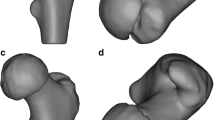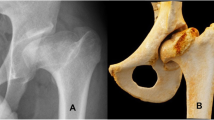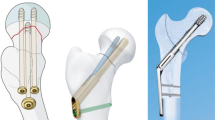Abstract
Background
To investigate the feasibility and accuracy of a drill template based on computer-aided design (CAD) and 3D printing technology for the placement of screws in Locking Compression Pediatric Hip Plate (LCP-PHP).
Methods
LCP-PHP was used in 11 children [5 with femoral neck fracture and 6 with development dysplasia of hip (DDH)]. Using the CT data, the proximal femur model was created by a 3D printer. Fracture reduction and the placement of the screw in the femoral neck and the LCP-PHP were simulated by the computer. The navigation template was designed by the software to match the proximal femur. After the feasibility of the 3D model operation was demonstrated before the operation, the guide pins and the screws were inserted with the help of the navigate template in the operation.
Results
During surgery, the navigation template for each case was matched to the bony markers of the proximal femur. With the help of the template, in femoral neck fracture cases, three screws could be accurately inserted into the femoral neck to implant the LCP-PHP and stabilize the fracture. The template for DDH includes all operation parameters and steps for proximal femoral varus rotation and shortening osteotomy, which made the surgery much easier to perform. Radiographs taken after surgery showed that the postoperative results closely corresponded to the preoperative computer simulation. The average time taken for LCP-PHP placement was 26.5 min; radiography was used during surgery only for an average of 6.0 times. Postoperative radiographs showed good results.
Conclusion
With the use of CAD and 3D printing technology, accurate placement of individualized navigation template of LCP-PHP can be achieved. This technology can reduce intraoperative damage to the femoral neck epiphysis, decrease operation time, reduce intraoperative hemorrhage, and decrease radiation exposure to patients and personnel during the surgery.




Similar content being viewed by others
References
Joeris A, Audigé L, Ziebarth K, SlongoT (2012) The Locking Compression Paediatric Hip Plate: technical guide and critical analysis. Int Orthop 36(11):2299–2306. doi:10.1007/s00264-012-1643-1
Ročák K, Poul J, Urbášek K (2013) Accuracy of proximal femur correction achieved with LCP Paediatric Hip Plates. Acta Chir Orthop Traumatol Cech 80(4):273–277
Sidler-Maier CC, Reidy K, Huber H, Dierauer S, Ramseier LE (2014) LCP \(140^{\circ }\) Pediatric Hip Plate for fixation of proximal femoral valgisation osteotomy. J Child Orthop 8(1):29–35. doi:10.1007/s11832-014-0550-y
Zhou Leena, Camp Mark, Gahukamble Abhay, Khot A, Graham HK (2015) Cannulated, locking blade plates for proximal femoral osteotomy in children and adolescents. J Child Orthop 9:121–127. doi:10.1007/s11832-015-0649-9
Spence D, DiMauro JP, Miller PE, Glotzbecker MP, Hedequist DJ, Shore BJ (2016) Osteonecrosis after femoral neck fractures in children and adolescents: analysis of risk factors. J Pediatr Orthop 36(2):111–116. doi:10.1097/BPO.0000000000000424
Maeda S, Kita A, Fujii G, Funayama K, Yamada N, Kokubun S (2003) Avascular necrosis associated with fractures of the femoral neck in children: histological evaluation of core biopsies of the femoral head. Injury 34(4):283–286
Chen H, Wang G, Li R, Sun Y, Wang F, Zhao H, Zhang P, Zhang X (2016) A novel navigation template for fixation of acetabular posterior column fractures with antegrade lag screws: design and application. Int Orthop 40(4):827–34. doi:10.1007/s00264-015-2813-8
Kaneyama S, Sugawara T, Sumi M (2015) Safe and accurate midcervical pedicle screw insertion procedure with the patient-specific screw guide template system. Spine (Phila Pa 1976) 40(6):341–348. doi:10.1007/s00264-015-2813-8
Ye N, Long H, Zhu S, Yang Y, Lai W, Hu J (2015) The accuracy of computer image-guided template for mandibular angle ostectomy. Aesthet Plast Surg 39(1):117–123. doi:10.1007/s00266-014-0424-1
Huang X, Li F, Zhang F, Wang K, Wang K, Yang Q, Dang R, Su J, Shen H, Li M (2014) A cadaveric study on establishing an individualized navigation template for the placement of occipital condyle screws using a three-dimensional printing technique. Zhonghua Wai Ke Za Zhi 52(7):523–528
Li L, Zhao GQ, Zhu J (2013) Treatment of trochanteric fracture in children with LCP-PHP. Chin J Pediatr Surg 34(6):474–476
Kunz M, Rudan JF, Xenoyannis GL, Ellis RE (2010) Computer-assisted hip resurfacing using individualized drill templates. J Arthroplasty 25(4):600–606. doi:10.1016/j.arth.2009.03.023
Kunz M, Balaketheeswaran S, Ellis RE, Rudan JF (2015) The influence of osteophyte depiction in CT for patient-specific guided hip resurfacing procedures. Int J Comput Assist Radiol Surg 10(6):717–726. doi:10.1007/s11548-015-1200-7
Hananouchi T, Saito M, Koyama T, Sugano N, Yoshikawa H (2010) Tailor-made surgical guide reduces incidence of outliers of cup placement. Clin Orthop Relat Res 468(4):1088–1095. doi:10.1007/s11999-009-0994-4
Zhang YZ, Chen B, Lu S, Yang Y, Zhao JM, Liu R, Li YB, Pei GX (2011) Preliminary application of computer-assisted patient-specific acetabular navigational template for total hip arthroplasty in adult single development dysplasia of the hip. Int J Med Robot 7(4):469–474. doi:10.1002/rcs.423
Audenaert E, De Smedt K, Gelaude F, Clijmans T, Pattyn C, Geebelen B (2011) A custom-made guide for femoral component positioning in hip resurfacing arthroplasty: development and validation study. Comput Aided Surg 16(6):304–309. doi:10.3109/10929088.2011.613951
Funding
This research did not receive any specific grant from any funding agency in the public, commercial or not-for-profit sector.
Author information
Authors and Affiliations
Corresponding author
Ethics declarations
Conflict of interest
The authors declare that they have no conflict of interest.
Ethical approval
All procedures performed in studies involving human participants were in accordance with the ethical standards of the institutional and/or national research committee and with the 1964 Helsinki declaration and its later amendments or comparable ethical standards.
Informed consent
Informed consent was obtained from all individual participants included in the study.
Additional information
Pengfei Zheng and Qingqiang Yao contributed equally to this work.
Rights and permissions
About this article
Cite this article
Zheng, P., Yao, Q., Xu, P. et al. Application of computer-aided design and 3D-printed navigation template in Locking Compression Pediatric Hip Plate\(^{\mathrm{TM}}\) placement for pediatric hip disease. Int J CARS 12, 865–871 (2017). https://doi.org/10.1007/s11548-017-1535-3
Received:
Accepted:
Published:
Issue Date:
DOI: https://doi.org/10.1007/s11548-017-1535-3




